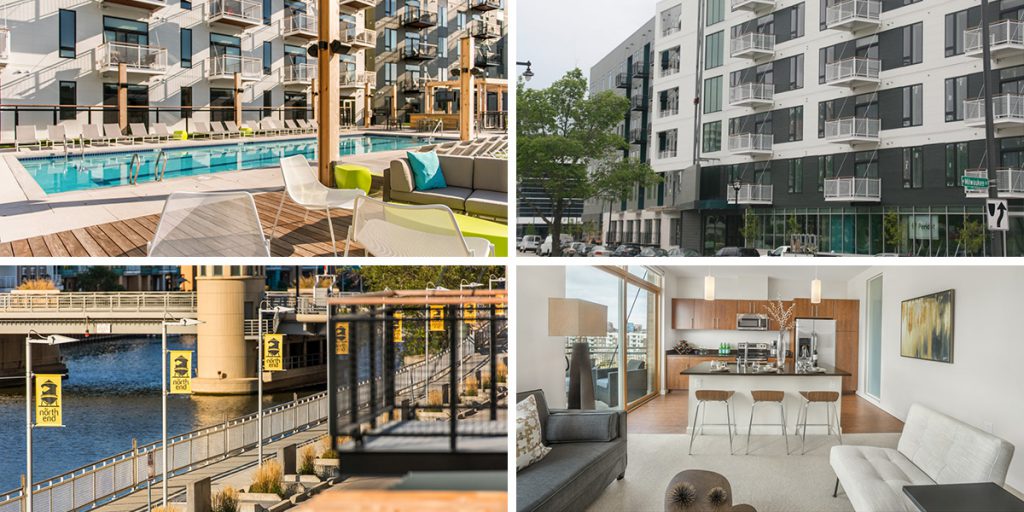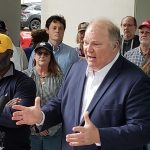Downtown Has Added 11,450 Housing Units
All under Barrett, all since 2004. But what about the rest of the city?
It’s obvious that downtown Milwaukee has grown in recent years, but by how much? By quite a bit, it turns out.
Department of City Development Commissioner Rocky Marcoux told members of the Common Council’s Zoning, Neighborhoods & Development Committee that since Mayor Tom Barrett took office in 2004, 11,450 housing units have been constructed in what he calls the greater downtown area. The area runs from E. North Ave. on the north edge to the Milwaukee River on the south, from Lake Michigan on the east to Interstate 43, W. McKinley Ave. and the Milwaukee River on the western edge. It encompasses all of the Westown, East Town, the Lower East Side, Beerline B and Historic Third Ward neighborhoods.
A unit is defined as a single residence within a larger building and does not reflect the number of bedrooms. Some units are large three-bedroom residences, but many are one-bedroom or studio apartments.
Marcoux, who was presenting a status update on a number of downtown projects, told the committee that 1,487 additional units are “in the queue and we believe will be in the ground this year.”
Outside of that area, the city has seen an additional 5,025 units constructed since 2004.
Is Downtown Overbuilt?
Alderwoman Milele A. Coggs asked Marcoux if the housing market is overbuilt. Marcoux responded that he has seen some signs the market is softening, citing deals where tenants can get a month of free rent with a year lease.
But overall, the commissioner said the city has a minimal risk even if the market is overbuilt. “We have not subsidized the downtown market. The market is acting as the market is going to act,” Marcoux said.
He did acknowledge the city has contributed heavily to projects like the Pabst Brewery redevelopment through a tax-incremental financing district, but said those funds went towards preparing the site and not actual housing.
The city does have one major investment pending, nearly $20 million is committed via a tax-incremental financing district towards The Couture. Those funds are intended to build a transit station and public concourse in the tower’s base. If the tower is constructed and its valuation fails to reach expected levels, the recovery of the city funds through property taxes could be delayed.
But Marcoux seemed unworried. “I think most of these properties are fairly unique because of their location,” he noted.
10,000 Unit Pledge from Barrett
At his State of the City speech delivered in late February, Barrett promised to create or rehabilitate 10,000 homes over the next ten years. As Marcoux’s numbers show, that isn’t something that will be easily accomplished. Downtown has become a very desirable area, yet has added less than 1,000 housing units per year, which is the pace of development Barrett has set as a future goal.
Marcoux said he’s working on the pledge and promised routine status updates. He told the council he had no intention of showing up seven years from now and having to say DCD is far behind the goal.
Single-Family Homes a Wash
One figure from Marcoux’s presentation caused debate among those present. The commissioner told the committee that since 2004 approximately 1,500 single-family or duplex houses have been constructed in the city.
Alderman Robert Bauman, who has pushed for funding for home repair programs, was quick to point out that the city has certainly demolished that many homes in the same period.
Marcoux responded to Bauman’s concern by noting that only 2.2 percent of land in the city is vacant, a number that has fallen since Marcoux took over as DCD leader.
While not much time was spent at the meeting on the issue, the balance of demolition versus construction and rehabilitation is something city officials will have to increasingly grapple with if Barrett’s goal of 10,000 affordable homes by 2028 is to be reached.
The city will have to increase the supply of homes to increase the population. A recent U.S. Census Bureau report found that Milwaukee County’s population fell for the third straight year, falling to 952,085 residents. The population of the region as a whole has been stagnant in the same time period.
If you think stories like this are important, become a member of Urban Milwaukee and help support real independent journalism. Plus you get some cool added benefits, all detailed here.
Political Contributions Tracker
Displaying political contributions between people mentioned in this story. Learn more.
- December 23, 2020 - Tom Barrett received $500 from Rocky Marcoux
- December 22, 2018 - Tom Barrett received $500 from Rocky Marcoux
- December 29, 2017 - Tom Barrett received $500 from Rocky Marcoux
- March 1, 2017 - Tom Barrett received $400 from Rocky Marcoux
Eyes on Milwaukee
-
Church, Cupid Partner On Affordable Housing
 Dec 4th, 2023 by Jeramey Jannene
Dec 4th, 2023 by Jeramey Jannene
-
Downtown Building Sells For Nearly Twice Its Assessed Value
 Nov 12th, 2023 by Jeramey Jannene
Nov 12th, 2023 by Jeramey Jannene
-
Immigration Office Moving To 310W Building
 Oct 25th, 2023 by Jeramey Jannene
Oct 25th, 2023 by Jeramey Jannene























I can understand why the County and City have lost population or have stayed the same. We’re a densely populated and built-out city and county. Furthermore, the drop in household size add to the reduction. What I don’t understand is why the region is not more dynamic.
I’d define “greater downtown” as Mitchell St. to North Ave, east of 27th street. And downtown as the geographic diamond created by Rockwell to Schlitz Park, the Courthouse to Northwest Mutual. Downtown is characterized by having many more jobs than residents, while greater downtown is the walkshed of downtown. The areas missing from Marcoux’s “greater downtown” definition, IMO, have been the most interesting in the last couple years, specifically the S 1st street corridor, the booming development around Iron Horse/5th & 6th streets, the immense amount of general business activity & activated storefronts along S 16th, Mitchell, and the continued sprawl of Marquette westward. If the DCD is going to put a thumb on the scale, Vliet & N 27th seem like the obvious corridors to try to put some investment. Also, we need to push hard on Madison to fix state route 59/national ave and state route 32/1st street-Chase, which are in tremendous conditions of disrepair in numerous sections throughout the greater downtown area.
@David. I’ve been pondering it quite a bit. We have many of the same urban design elements of Portland, Seattle, or Denver which are flourishing right now, plus our proximity to Chicago puts us in a comparatively better position to participate in a global knowledge economy. The level of activity within our creative class is very high. So there’s reasons to think we’d be attacking residents overall.
Compared to those cities, I do think our lack of robust public & active transportation options into downtown, which results in us having to pave over half the land area for commuter parking, is unnerving to visitors and really damages quality of place for residents & workers. Nationwide, cities that are paved over are struggling, but without transportation alternatives we’ll be stuck with these ugly lots in the core of our city for the foreseeable future.
And I think we’ve got a lot of opportunity to restore the commercial districts in our city neighborhoods and in the surrounding streetcar suburban cities. The prevailing trend right now is toward more urban village settings – which we could have a lot more should we eventually deal with all these nasty roads through the hearts of so many neighborhoods. For the $20M that we’re going to spend on the pedestrian overpass downtown, I’d love to redirect that and due five more S. 5th street-style projects. Honestly, I’d like for the city to do one or two 5th street-style projects every year for the next 2 decades. For the price of running our police department for about 3 months (125M), we could restore our 25 most important neighborhood centers to S. 5th street levels.
I wouldn’t put Denver in this category. Two months ago Urban Milwaukee had a story of about 15,000 upscale apartments being unoccupied in Denver. Denver officials began a project to subsidizing these empty homes. Milwaukee officials have done a good job in assisting developers in building residents that citizens can afford.
Milwaukee foreclosures up 21 percent during first quarter of 2018
U.S. foreclosure rate down 19 percent from Milwaukee Biz Times
https://www.biztimes.com/2018/industries/banking-finance/milwaukee-foreclosures-up-21-percent-during-first-quarter-of-2018/
@michael – I thought the Commissioner’s definition of the “greater downtown” was a bit odd as well. Why include all the way up to North Ave (the east side, not really downtown), but not include any portion of Walker’s Point and the south side? It’s about a mile from Water & Wisconsin to 1st & National, but almost 2 miles from Water & Wisconsin to Oakland & North.
I see little evidence to support the statement “Milwaukee officials have done a good job assisting developers in building residents(sic) that citizens can afford.” Rather the philosophy of “build baby build” consistently favors tax base expansion at the expense of social, environmental and quality of life issues.
Without strong and decisive action to more proactively address “affordable” housing development this City will soon face socioeconomic hypersegregation to its already hypersegregated racial mix.
@David Potts. What projects bother you? Almost everything has been on abandoned rail yards, the footprint of a removed elevated highway, parking lot, remediated brownfields, or the adaptive rehab of industrial buildings. I love seeing a long abandoned coal yard getting cleaned up and used for something productive, as is underway at the sovey sight.
I think milwaukee has done a good job at targeting development in these spots versus displacement in the neighborhoods.
David Potts nailed it. I’m certain that a majority of Milwaukeans would not consider the new construction referred to as affordable.
As a west sider who just came from a wonderful ski on the lakefront, yet enjoys the affordability of our neighborhood, I can attest to the continued preference for strategies that enhance bifurcation and support a general stasis in many west side neighborhoods. With few exceptions, 15 years of tax-base-enhancement-focus by City Hall has left much of the north side where it was in 2003, with the only significant change being a hodgepodge of developer friendly tax-credit housing projects.
No one opposes rail yard redevelopments as far as I know but theres more to the city than large redevelopment areas. And while I frequent some of the new developments and am thankful for them, subsidies for grocery stores at N Water and E Pleasant St mean fewer subidies where they could make substantive changes to communities elsewhere.